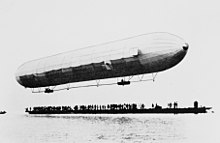硬式飛船
| 此條目需要擴充。 (2014年7月27日) |
硬式飛船(Rigid Airship)是指外形主要是以內建的框架來支撐住的飞艇,次要的支撐則和軟式飛船與半硬式飛船相同來自內裝氣體的壓力。[1][2]最著名的硬式飛船種類是齊柏林飛船。

硬式飛船盛行於1900年代至1930年代晚期,在興登堡號起火後開始退流行。
參考
- ^ Mueller, Joseph B.; Michael A. Paluszek; Yiyuan Zhao. Development of an aerodynamic model and control law design for a high altitude airship (PDF). American Institute of Aeronautics and Astronautics: 2. 2004 [2014-07-27]. (原始内容存档 (PDF)于2012-10-02).
In general, airships fall into one of two categories: pressurized or rigid. With pressurized models, the shape of the hull is maintained by a small pressure differential between the internal lifting gas and the external atmosphere. With rigid airships, the hull is formed by a lightweight skeletal structure with a fabric skin, while the lifting gas is stored in internal “gasbags”. The Graf Zeppelin II and the Hindenburg were both rigid airships. Pressure airships are sometimes made “semi-rigid” by adding a structural keel to share the bending loads generated from aerodynamic forces.
- ^ Konstantinov, Lev. The Basics of Gas and Heat Airship Theory. Montgolfier (Kyiv, Ukraine: AEROPLAST Inc). 2003, 1: 4–6, 8.
